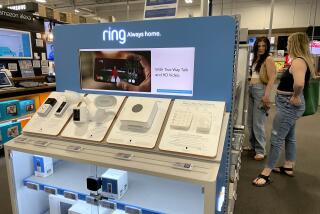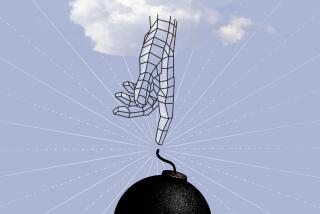Technology: A Boston medical writer sounds the alarm about the psychological cost of high-tech living. A first-aid kit for the future is a must, he says.
- Share via
The symptoms include tension, paranoia, overstimulation, anticipatory disaffiliation, psychosomatic headaches, fatigue, sagging libido, psychic numbing, low self-esteem and high anxiety.
What is the ailment?
“Technostress,” says Philip T. Nicholson, a Boston medical writer and seasoned watcher of Life in the Information Cyclone. He defines technostress as a contemporary disease caused by the pressures of living in a high-tech world.
“This can lead to panic, alienation and a sense of hopelessness,” says Nicholson, who is organizing a Technostress Information Network to coordinate research on the subject.
As our lives at home and at work become relentlessly computerized (President Bush’s recent quip about a nation where every citizen would be able to set the clock on his VCR indicates that technostress has struck the White House), and as we flounder in tides of information and electronic images and call-waiting buttons and laser printers and fax machines, we may experience not only headaches and back pains, but a range of contradictory psychological changes, such as sharp impatience with any process that takes more than a few seconds, or the inability to make decisions.
Considering that rapid technological change is expected to whiz us right into the 21st Century, Nicholson is convinced that studying the prospects for humankind in a nanosecond-paced world is a necessity.
“What I’m doing is looking at the eroding aspects of the communications revolution,” he says. “Somebody needs to be designing a technostress first-aid kit for the future--thinking about the glue that will hold people together.”
Nicholson sees his role as sounding the alarm, but he is not alone. Although technostress has not been officially recognized in the medical Establishment (a spokesman for the American Psychiatric Assn. did acknowledge a concern over growing symptoms of mechanization and dehumanization), it is attracting researchers from all disciplines. Studies on the effects of computerization on humans can be weighed by the ton.
Craig Brod, a Silicon Valley psychotherapist who coined the phrase in his 1984 book “Technostress,” agrees with Nicholson that we are producing a technological society that is leaving us tuned into machines but starved for personal contact.
In clinical interviews, Brod noticed similar patterns in patients who worked with high technology, whether they were data processors or CEOs. Not only were they suffering such stress symptoms as headaches, but they also were internalizing the computer process itself, developing such behavioral symptoms as a sense of accelerated time, a desire for perfection, and difficulty in relating lovingly to others.
“With a typewriter there were time and motion interruptions when you tore up a piece of paper or hit the carriage return--there were all kinds of separations between you and the machine,” says Brod. “Then comes this wonderful technology that alters time. You can work for hours being almost motionless, and basically you are hooked into this machine.”
The key, he thinks, is that high-tech environments create their own kind of stress--the stress for perfection--and when life falls short of that, technostress victims react with “a lot of anger and hostility.”
What alarms Brod is the disappearance of a “human sense of time” on a widespread public scale as society becomes increasingly computerized. He sees symptoms everywhere. For example:
* We used to get money by standing in line at the bank and exchanging greetings with the teller. Now we withdraw money from a self-service automated teller, and if it takes more than 60 seconds we get impatient.
* At the market, we shuffle past a checkout clerk who is frantically running groceries over a computer scanner. Clerks now handle two and three times as many people in their lines as they used to, so they can’t afford to stop and say “hello.”
* On the telephone we used to give the number to an operator, and sometimes ask for help finding a number. Now the telephone is so automated that machines answer when the phones ring.
* Many offices are so computerized that even people sitting next to each other converse by electronic messages. The office water cooler conversation is history.
In every direction, “we are producing this automated society not meeting our needs for personal contact, for a human sense of time,” says Brod. “I even have patients who ask me how much time they should spend with their children.”
Brod foresees an eventual revolt if technostress is not addressed because “we are automating the human element out of our lives.”
Other experts see the technostress problem through a different lens.
At USC, Ann Majchrzak, an organizational psychologist, says workplace stress isn’t caused by technology itself but by the way management handles it.
“My research shows a critical correlation between the amount of time you give employees to prepare for the new technology and their acceptance of it,” says Majchrzak who helps managers lay the groundwork for introducing new technology to workers.
“That new software package comes in the door with only the manual, and technostress happens when you get companies who do training once, then keep handing the updated packages to the workers. (Many clerical computer workers report learning as many as 20 new software programs in the last two or three years).
“We’re in the midst of a hardware revolution and a software revolution,” she says, “and the combination of the two is very challenging. Workers are going to participate in the change or fall by the wayside, and they need management support.”
The most successful firms today devote up to 10% of their time to ongoing high-tech training, which means that workers are spending four hours a week learning something new.
“That means you are not in a stable work environment, and I think that is the case for almost everybody today,” she said.
If the workplace computer keeps its user in a state of change, the home computer tends to reinforce a household’s existing family pattern, whether healthy or dysfunctional.
“When a computer comes into a home, it does have impact and the impact is a shift in how people use their time,” said Nicholas Vitalari of UC Irvine, who studies information systems and the social impact of computer technology.
With fellow UCI management professor Alladi Venketesh, he conducted the NOAH (National Outlook for Automation in the Home) project for the National Science Foundation. The two-year study, the first of its kind, tracked personal computer use in 900 U.S. households.
Like many researchers, the two were intrigued by the technological explosion of the 1980s which saw computer households grow from 1 million in 1980 to nearly 35 million in 1990 (out of 90 million U.S. households).
“When we did pilot studies, it became very clear that buying a computer is very different from buying a toaster. You know what a toaster does,” says Vitalari.
At home, the computer’s role waits to be defined. What researchers found is that “people didn’t really know what they wanted. Early on they thought they could do their home finances, balance their checkbook, keep records, that sort of thing.
“That turned out to be unrealistic, in most cases. Primarily, the computer is used by children to do homework and by adults to extend their workweek by doing work at home,” he says.
Research revealed that as the computer ate into an adult’s leisure hours, trade-offs had to occur. “Usually it meant less time sleeping and less time spent watching television. These were statistically significant,” says Vitalari.
And although their study showed that most people were happy, not stressed, with their home computers, he said, “you do run across interesting situations that are cause for concern.”
These are the homes where using the computer becomes a way to act out dysfunctional relationships, he said, such as a husband making his wife a computer widow.
“There were situations where the female spouse sees the computer as an invasion of the household unit, so you know there is something else going on,” he said. “We also found situations where the female brings the computer into the home, and she and the kids bond around it.”
On the other hand, Vitalari said, their research showed that the computer can reinforce a healthy family--”one Northern California family linked together by computer when their children went off to college.”
And in one single-parent household where the mother and children had a good relationship, the mother used the electronic mail system at her office to leave messages that the children called up on the home computer.
“It’s like an electronic refrigerator door,” said Vitalari.
The high-tech relationship achievable between an individual and a machine spurred Philip Nicholson to organize his Technostress Information Network.
“It’s not that people want to bail out; it’s the intoxication with technology that is unsettling,” he said.
Nicholson, 45, has an interdisciplinary degree from Stanford University in law and psychiatry and a master’s degree from Harvard in public health. He has been “intoxicated” with technology since he bought his first word processor in 1978.
“It was a great big clunky beige-and-black Lanier and it cost $14,000,” he recalls. “I tripled my output of medical writing and paid back the investment in six months.”
Five years later, the microcomputer boom washed over everything and Nicholson got interested in the future of humans faced with an accelerating rate of high-tech speed and information.
“I was fascinated by the technology, but also feeling the psychological consequences,” he said. “I had the best education money can buy, and a nice family, but I still felt like I was just hanging on the edge, and all my friends were feeling the same way.”
When Nicholson began to compile technostress research, he realized he was not alone in his feelings. Technostress was an unidentified epidemic. He devised a chart of symptoms, including an “Information Worker’s Spiral of Ascending Anxiety,” that he uses for the lectures he hopes will spread the word.
So far, Nicholson hasn’t made much impact.
“People are not swarming to this subject,” he says. When he addressed the World Future Society last summer on “Conservation of the Self in a High-Tech Environment,” he found the lack of interest disappointing. “This should be a major concern for futurists.”
He also thinks technostress research could be of interest to the computer industry, human factors specialists, psychologists, psychiatrists, sociologists and “anybody else interested in behavioral sciences.”
In Silicon Valley, Brod agrees. “I think people need a place to think about this whole question of speeded-up life. I want a broader discussion of this. It’s a contemporary disease and it needs to be acknowledged.”
In the meantime, Brod offers this self-help prescription:
* Don’t blame the victim. And if you are a sufferer of technostress don’t blame yourself.
* Analyze the symptoms. Look at the work environment, the way things are arranged. Ask questions about how much work people really can take, about the best human flow of communication.
* Ask yourself questions about how you are spending your time.






